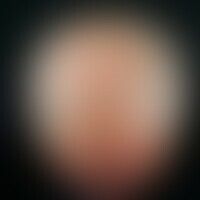Alopecia androgenetica in men, stage II/III: receding forehead-hair boundaries, especially at the temples with fronto-parietal hair thinning and formation of receding hairline.
Go to article
Alopecia androgenetica in men, stage III/IV: Confluence of anterior and posterior hair thinning in the parietal region.
Go to article
Alopecia androgenetica in men; stage IV: horseshoe-shaped, complete clearing of the hair in the parietal region; remaining lateral and posterior crown of hair
Go to article
Alopecia androgenetica in men. stage V: Almost complete hair loss with a narrow, thin ring of hair at the sides and back in a 50-year-old man.
Go to article
Alopecia androgenetica in man. stage IV: Remaining lateral and posterior hairline in a 38-year-old man.
Go to article
Alopecia androgenetica in a female patient: Stage III: Pronounced hair thinning in the frontoparietal region with frontal hairline in a 56-year-old female patient.
Go to article
Alopecia androgenetica in the woman; distinct hair thinning in the parietal region in a 28-year-old female patient.
Go to article
Alopecia androgenetica in the female. classic, initial androgenetic alopecia of the female pattern, with preserved frontal hair and emphasis on the high-parietal hair areas in a 16-year-old female patient. secondary findings are generalized hypertrichosis since childhood. the patient's sister is also affected, previous generations are all free of symptoms.
Go to article
Alopecia areata: Beginningnew hair growth of a hairless area in an 8-year-old girl which has existed for a few months.
Go to article
Alopecia areata. roundish, centrifugally and medially spreading, smooth, hairless areas with preserved follicles. in the active marginal area hair can be pulled out in tufts. under internal steroid treatment with methylprednisolone for 4 weeks the hair loss stopped and re-growth in places occurred.
Go to article
Alopecia areata: Still relapsing-active alopecia areata: Marginal area, cadaverized hair and exclamation mark-like hair, as a sign of the still existing progression of the process.
Go to article
Alopecia areata: Complete loss of eyebrows and eyelashes.
Go to article
Alopecia areata: Typical clinical finding of an alopecia areata with concomitant circumscribed scleroderma.
Go to article
Alopecia areata universalis. initially circular hair loss with rapid progression, which led to hairlessness of the entire scalp. the remaining body hair of the 16-year-old patient is not affected.
Go to article
Alopecia, scarring. multiple, smooth atrophic, laterally sharply defined, slightly reddened, alopecic areas persisting for several years in a 57-year-old patient with proven chronic discoid lupus erythematosus.
Go to article
Alopecia, scarring alopecia in a 13-year-old female patient with known lupus erythematosus without systemic involvement.
Go to article
Alopecia, scarring. 2 years of rapidly progressing, very extensive, diffuse, scarring (no follicular structures detectable in the alopecic foci even with magnifying glass enlargement) hair loss in severely reddened scalp in a 73-year-old patient with Sézary syndrome. The patient previously had only slight alopecia androgenetica (stage II).
Go to article
Alopecia, scarring. dynamically progressing, increasing inflammatory, scarring hairlessness in generalized dyskeratosis follicularis.
Go to article
Alopecia, scarring. detail from above picture: Patient with generalized dyskeratosis follicularis. multiple, whitish, smooth scars without preserved follicular structures besides dyskeratosis.
Go to article
Alopecia marginalis. 6 months of persistent, progressive hair loss at the traction points for the fixation of composite parts of a hair replacement woven in for 8 years in a 37-year-old female patient. In the picture a skin-coloured scar plate is centrally impressing, which has existed since birth (Pat. had as a twin almost grown together with his sibling).
Go to article
Alopecia marginalis. detail enlargement: Since 6 months persistent, progressive hair loss at the traction points for fixation of composite parts of a hair replacement woven in for 8 years in a 37-year-old female patient. In the picture a skin-coloured scar plate is centrally impressing.
Go to article
Alopecia marginalis: Hair thinning and focal hairlessness due to constant, hairstyle-related pulling on the hair at the forehead hairline and parietally. 22-year-old woman who until recently wore tightly bound raster curls.
Go to article
Alopecia neurodermitica. general view: Chronic stationary, temporally to occipitally localized, large-area, diffuse hair loss in a 53-year-old female patient with atopic eczema since childhood. the scalp is partly diffusely reddened, the follicles are preserved. isolated scratch artefacts are visible. the patient also suffers from bronchial asthma and seasonal allergic rhinoconjunctivalis.
Go to article
Alopecia neurodermitica, detailed view of the findings in the patient described in detail above.
Go to article
Alopecia parvimaculata, multiple, spotty-scarred alopecia in a 33-year-old man. The skin lesions persist since a tinea capitis favosa in childhood.
Go to article
























